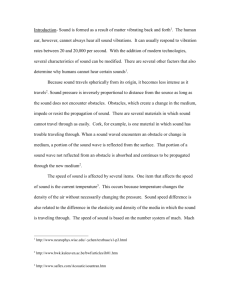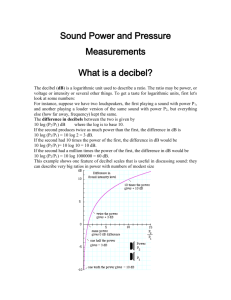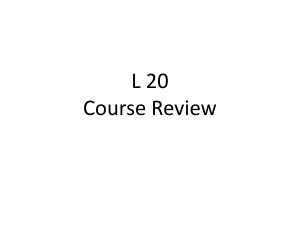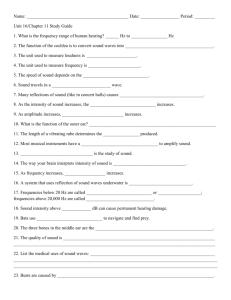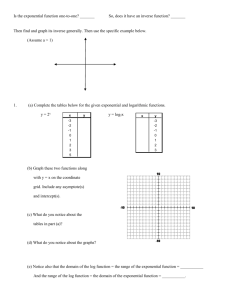HEARING
advertisement
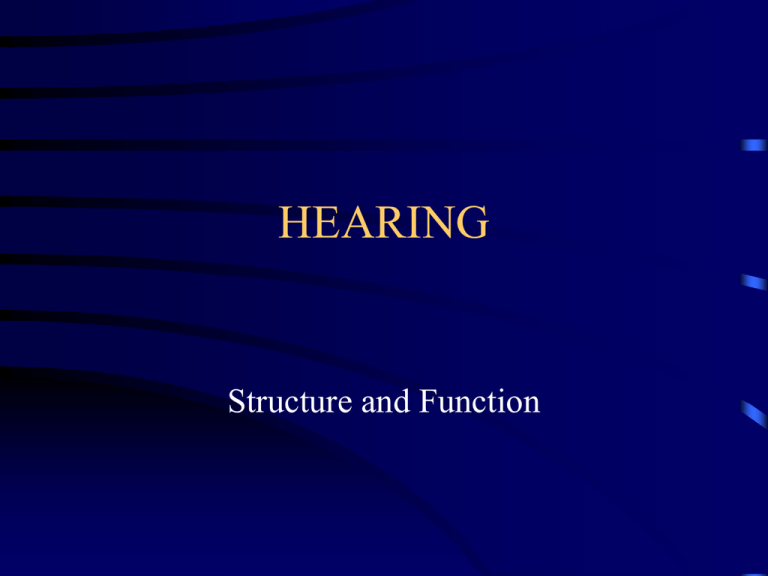
HEARING Structure and Function Function of auditory system • Analyse • Discriminate -sounds - widely varying intensity widely varying frequencies any spatial direction complex varying patterns of pressure and frequency which differ at the two ears Action of human ears is to interpret sound input by perceiving: intensity, frequency, timbre, localisation & masking of one sound by another. Definitions (subjective correlations) • • • • • Intensity Frequency Timbre Localisation Masking = = = = = Loudness Pitch Musical quality Spatial position One sound is selectively heard in preference to others Measurement • Sound intensity is normally measured in N/m² or Pascals • The vast range of sound pressures perceived by humans is more conveniently described by a smaller range expressed in a logarithmic scale as decibels as a ratio of a reference intensity (2 x 10⁻⁵ N/m²) Measurement • Human range is: 0 db “absolute” threshold - 130 dB pain threshold 0 dB is a reference point for the “average” Step sizes less than 1 dB are rarely detectable Changes in intensity of equal numbers of dB correspond to approximately equal steps in loudness 0 dB is a reference point for the “average” Step sizes less than 1 dB are rarely detectable Changes in intensity of equal numbers of dB correspond to approximately equal steps in loudness 0 dB is a reference point for the “average” Step sizes less than 1 dB are rarely detectable Changes in intensity of equal numbers of dB correspond to approximately equal steps in loudness Some levels • From 1 m - whisper - conversation - shout - discomfort - 30 dB - 60 dB - 90 db - 120 dB Definitions (subjective correlations) • • • • • Intensity Frequency Timbre Localisation Masking = = = = = Loudness Pitch Musical quality Spatial position One sound is selectively heard in preference to others Measurement • Frequency is measured in Hz • Frequency has the subjective correlate of pitch which is how the ear perceives changes in frequency • However, complex sound has no clear specific pitch and the hearing apparatus has to sort the complex input and produce an intelligible interpretation Measurement • Human ear can appreciate frequencies between 12Hz and 20 000Hz (some people have greater range) modern piano keyboard is 25Hz – 4000Hz • “Speech range” is 200Hz - 10 000Hz (mostly utilise 500-4000 Hz) • Music 50Hz - 20 000Hz Definitions (subjective correlations) • • • • • Intensity Frequency Timbre Localisation Masking = = = = = Loudness Pitch (musical) quality Spatial position One sound is selectively heard in preference to others Timbre • The fundamental frequency is the lowest note in a complex sound • The overtones or harmonics are simple multiples of the fundamental frequency and are responsible for the quality of the sound Definitions (subjective correlations) • • • • • Intensity Frequency Timbre Localisation Masking = = = = = Loudness Pitch Musical quality Spatial position One sound is selectively heard in preference to others Ear • Conducting apparatus - auricle - EAC - TM - ossicular chain - IE fluids • Perceiving apparatus - end-organ (Corti) - VIII - cerebral cortex - External ear • Pinna / auricle • Skin covered cartilage • “Directs” sound into EAC External ear canal • Skin covered cartilage and bony canal • Channels acoustic energy to TM Tympanic membrane • 3 layers: – Squamous epithelium fibrous tissue – Respiratory mucous membrane Middle Ear • Contains: malleus incus stapes - • Small “auditory muscles” hammer anvil stirrup Transformer • Acoustic energy arrives at TM & is transmitted to the stapes footplate - area ratio TM : footplate - lever effect of ossicles = 14:1 = 1,3:1 - overall “transformer ratio” = 18:1 • Amplitude of vibration at TM is reduced by the time it reaches the footplate • Force entering fluids is increased in same proportion • Widely differing acoustic resistances between air & fluid are matched • Transfers maximum energy from air to fluid • Stapedius & tensor tympani muscles reflexly contract above 90 dB • This attenuates loud sound to protect IE against acoustic trauma Impact / explosion noise reaches cochlea before reflexes can act – damage is worse than with steady state noise Physiology • Sound is transmitted to IE in three ways: 1. Via the ossicular chain - most important 2. Bone conduction – through bones of the skull, sound energy taken up and transmitted to cochlea 3. Directly across ME – on to round window when there is TM perforation Physiology • Airborne sound – vibrations of atmosphere – pass along the EAC to the TM - set in motion • Transmitted to ossicles – which rotate around fulcrum & transmit vibrations to oval window Physiology • Transmitted through oval window to perilymph in scala vestibuli around the helicotrema to round window (reciprocal movement) Physiology • This sets up a travelling wave starting from the cochlea base & progressing toward the helicotrema with increasing amplitude • There is a sharply defined region of maximum displacement – position depends on frequency Physiology • High frequency – maximum displacement at basal turn of cochlea • Low frequency – longer travelling wave with maximum amplitude nearer the helicotrema Physiology • Vibrations displace basilar membrane – shearing movement between hair cells and tectorial membrane – hairs displaced in relation to their bodies • Not fully understood but this displacement results in neuronal stimulation - nerve impulses in VIII Neuronal stimulation • 3 main theories • Attempt to explain conversion of all varied dimensions of sound • Possible variations in nerve action potentials depend upon Neuronal stimulation • Particular nerve fibre being activated – place along basilar membrane • Total numbers of fibres activated louder sound – more activated • Threshold of individual fibres – majority of fibres have threshold 10-15 dB only a few above 80 dB Internal Auditory Canal • ± 1 cm long • In petrous temporal bone • Transmits - VII - VIII - internal auditory art. & vein Audiometry • Pure Tone Audiogram (PTA) is the cornerstone of assessment of hearing • Establishes subject’s pure tone hearing threshold – the minimum sound level at which a specific response can be obtained Audiometry • Test 125, 250, 500, 1000, 2000, 4000, 8000 Hz (3000 & 6000 for noise-induced loss claims ) • Air conduction • Bone conduction - not 125 & above 4000 as unreliable - indication of cochlea function Audiometry • • • • Soundproof room Earphones / bone conductor Subject signals by pressing button Pure tones produced by calibrated audiometer • Intensities - 20 dB + 110 dB Normal audiogram Speech vs Pure tone • Main function of human ear is perception of spoken word • Speech consists of very complex sound • • • • Varying frequencies – fundamentals & harmonics Vowels & consonants Accents Languages Speech vs Pure tone • PTA is not always good assessment of speech discrimination • Speech Audiometry measures actual disability produced by any hearing loss Definitions (subjective correlations) • • • • • Intensity Frequency Timbre Localisation Masking = = = = = Loudness Pitch Musical quality Spatial position One sound is selectively heard in preference to others Localisation - Binaural hearing - differences in time of arrival (10-20μs) - differences in intensity at two ears - phase differences ( at less than 1500Hz) Localisation - Pinnae - spectrum of sound entering ear modified by pinna in a way that depends on direction of sound source Localisation - Precedence effect • Many different paths - direct - reflected (echoes) Several sounds in close succession are the direct sound & its echoes. These are perceptually fused and the location of the total sound is determined by the combination of the direct sound and its echoes. Complex? Fascinating? Want to know more?

